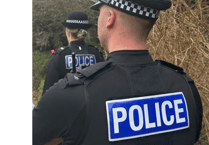MYSTERY continues to shroud the death of the baby girl, whose body was found at Arch Brook Creek, Combeinteignhead, last September, after an open verdict was recorded at the inquest in Teignmouth om Tuesday.
Bitton House was conspicuously empty of the usual family members associated with inquests as South Devon Coroner, Hamish Turner, led proceedings which lasted just 20 minutes.
The body of the baby, named Amanda by the police, was found by Stokeinteignhead fisherman Barry Kingwell, who made the discovery as he washed his wading boots in the creek just before 10am on Tuesday, September 3.
It was after checking his crab pots, situated 500 yards up stream from the Arch Brook road bridge, that Mr Kingwell, as he does each week, went along to the shallow water near the bridge to wash the mud from his waders and gloves.
'I noticed a white sack in the reeds,' said Mr Kingwell. 'I had found things dumped in sacks there before – sheep, dogs, a cat, so in my curiosity that's what I thought it was.
'I pulled the sack from the reeds, pulled back one sack and I could see the blood. I pulled at the second sack, a brown towel fell out and I could see the baby.'
The caucasian baby still had its umbilical cord attached and what Mr Kingwell described as 'a mass of black hair'.
'I put the towel back over it again because by then people were driving over the bridge and looking down,' he continued.
Mr Kingwell then struggled to flag down passing cars for some minutes before a lorry stopped and he was able to borrow a mobile phone to call the police.
Coroner's officer, Richard Parsons, who received the baby at Torbay Hospital mortuary later that morning, described her as: 'A full-term, new-born baby, with some signs of birth trauma, initially alive through the passage of birth at least.'
Guan Fernando, the home office pathologist who carried out a post mortem at Torquay mortuary that afternoon, concluded that death was due to 'lack of care at birth'.
Detective Sergeant Ken Lamont, the deputy senior investigating officer in the case, said the police enquiries had taken two directions; one to find the cause of death, the other to find the mother.
Expert forensic advice was obtained from London, where toxicology and diatom tests had been carried out. While these tests were not able to specify cause of death, the lack of diatoms did allow the police to rule out drowning.
Giving his verdict, Mr Turner said: 'It seems unusual that someone wouldn't know that someone had given birth or was about to give birth to a bouncing, 9lb child. It's very sad that there maybe someone out there who needs some support following the birth.
'Although lack of care at birth can be a verdict, I think that in the circumstances I will record an open verdict.'
Speaking after the inquest, DS Lamont said that the DNA profile of the baby's mother and half that of the father, obtained from the baby's blood and other blood found at the scene, had formed part of an 'intelligence led screening process,' through which the profiles were compared against other available DNA information.
'Because there was an open verdict, today has not drawn a line underneath the enquiry at all,' said DS Lamont. 'We have been told by the forensics team in London to focus our enquiry not on how the baby died, but why she is no longer alive.'
DS Lamont also said that information regarding the sack in which the baby was found had allowed them to significantly narrow their lines of enquiry in the search for the mother.



